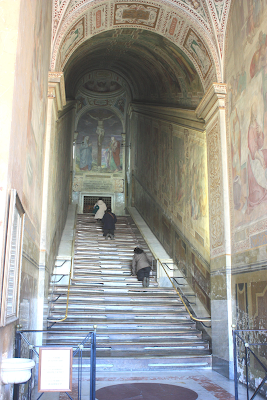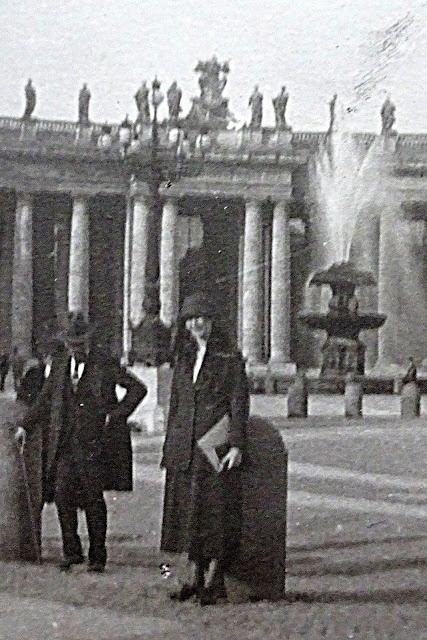M.004.02 - View of Ceramicos (Kerameikos), Athens
Kerameikos, also known by its Latinized form Ceramicus, is an area of Athens, Greece, located to the northwest of the Acropolis --- It was the potters' quarter of the city, from which the English word "ceramic" is derived, and was also the site of an important cemetery and numerous funerary sculptures erected along the Sacred Way, a road from Athens to Eleusis. [Wikipedia - Kermeikos]
From: Gerda (year and date unknown)
Hj. hälsningar, syster Gerda
The Acropolis of Athens is an ancient citadel located on a rocky outcrop above the city of Athens and contains the remains of several ancient buildings of great architectural and historical significance, the most famous being the Parthenon. The word acropolis is from the Greek words ἄκρον (akron, "highest point, extremity") and πόλις (polis, "city"). [Wikipedia - Acropolis of Athens]
To: Gustaf Samuelsson, Prästgården*, Fristad, Suède
From: Gerda (Athens, 20 April - year unknown)
*Prästgården = The Vicarage. Besides being a farmer, Gustaf was also a churchwarden (cf previous post). I suppose he must have been staying there a while for some special job.
Athen d. 20-4
Käre bror! Nu är denna resan över. I morgon reser vi till Rom igen, Grand Hotel. Det har varit mycke intressant här. Men det är för varmt. Kära hälsningar, Gerda.
Dear Brother, Now this trip is over. Tomorrow we go back to Rome again, Grand Hotel. It has been very interesting here. But it is too hot. Love, Gerda.
With the year missing on both these cards, I'm not really sure when Gerda visited Athens. But the note about going "back to Rome again" gives me a clue. In my post for SS 617, in which there is a card with a picture from Livorno, posted from Stockholm in June 1930, I arrived at the conclusion that Gerda was more likely to have visited Italy in 1929 than in the spring of 1930 (considering the birth of the Bernadottes' first child in January that year). And if Livorno, why not also Rome - and Athens.
Among Gerda's blank postcards that she saved for herself, there are also two more from Italy: one of a hotel in Venice, and one of the 'Scala Sancta' (Holy Stairs) in Rome.
M.032.01 - Rome, Scala Sancta (blank card)
 |
| Roma - Scala Santa Rome - The Holy Stairs |
 |
| Photo of the Scala Sancta from Wikipedia |
The Scala Sancta (English: Holy Stairs, Italian: Scala Santa) are a set of 28 white marble steps that are Roman Catholic relics [---] According to Roman Catholic tradition, the Holy Stairs were the steps leading up to the praetorium of Pontius Pilate in Jerusalem on which Jesus Christ stepped on his way to trial during his Passion. The Stairs reputedly were brought to Rome by Saint Helena in the fourth century. For centuries, the Scala Sancta has attracted Christian pilgrims who wish to honour the Passion of Jesus Christ. [Wikipedia - Scala Sancta]
I'm impressed! St. Peter's Square within the Vatican City in Rome it is!
 |
| Photo from Wikimedia, 2005 |
Linking to: Sepia Saturday 622
 |
| "This week our theme turns the spotlight on the art of waiting: for a bus, for a friend, for a future... for anything." |
SVENSKA
M.004.02 - Vy från
Kerameikos, Aten
Hj. hälsningar, syster Gerda
Kerameikos (grekiska: Κεραμεικός) är ett område i Aten, nordväst om Akropolis, vilket innefattar ett stort område både inom och utanför stadsmurarna. --- Det var keramikernas kvarter, därav namnet som kommer från ordet keramik. [Wikipedia]
M.004.03 – Aten med Akropolis
Athen d. 20-4
Käre bror! Nu är denna
resan över. I morgon reser vi till Rom igen, Grand Hotel. Det har
varit mycke intressant här. Men det är för varmt. Kära
hälsningar, Gerda.
Akropol är en befäst stad, belägen på en klipphöjd i antikens Grekland. Namnet är sammansatt av grekiska akros ('överst') och polis ('stad'). Där låg stadens kärna och helgedomar. [Wikipedia]
[Detta kort är adresserat till Gustaf på Prästgården i Fristad istället för till Storegården. Jmf föregående blogginlägg: Enligt folkräkningen 1930 var Gustaf förutom jordbrukare också kyrkvakt. Jag antar att han måste ha bott på Prästgården ett tag i samband med något större jobb för kyrkan – tillräckligt länge för att be Gerda, i Grekland, skriva till den adressen istället för till Storegården!]
Då årtalet saknas på båda dessa vykort från Aten är jag inte säker på när Gerda besökte staden. Men hennes upplysning att de är på väg att resa "till Rom igen” ger en ledtråd: I mitt inlägg för Sepia Saturday 617 fanns ett vykort med bild från Livorno (i Italien) men sänt från Stockholm i juni 1930. Jag kom där fram till att det dock var mer troligt att Gerda (med paret Bernadotte) besökt Italien 1929 snarare än våren 1930 – med tanke på att paret Bernadottes förste son föddes i slutet av januari 1930.
Bland Gerdas oskrivna vykort finns också två andra vyer från Italien: en från ett hotell i Venedig, och ett av 'Scala Sancta', 'Heliga trappan', i Rom.
M.032.02 – Venedig, Hôtel Excelsior
M.032.01 - Rome, Scala Sancta
Scala Santa, italienska Scala Sancta (Heliga trappan), är en trappa inhyst i resterna av ett medeltida palats i närheten av basilikan San Giovanni in Laterano i södra Rom. Enligt romersk-katolsk tradition är denna trappa identisk med den trappa som Jesus beträdde i Pontius Pilatus palats i Jerusalem. Enligt samma tradition var det Sankta Helena som såg till att trappan hamnade i Rom på 300-talet. Trappan är gjord av marmor men klädd i trä för att skydda den. Scala Santa är ett välkänt pilgrimsmål, och uppför denna trappa går de troende på knä under bön. [Wikipedia]
I Gerdas fotoalbum fann jag också ett foto som såg ut att kunna vara från antingen Aten eller Rom. Det är i mycket litet format i albumet (5x7 cm) och ganska suddigt. Jag bearbetade det i mitt vanliga fotoredigeringsverktyg (Picasa 3) och lyckades förstora det tillräckligt för att konstatera att ja, det är säkert Gerda som står där framför en antik pelararkad i bakgrunden... men var?
Jag erinrade mig något jag hört talas om men ännu inte testat: Google Image Search (bildsök). Det fungerade över förväntan och jag kan konstatera att platsen är Petersplatsen i Vatikanstaten i Rom. Där stod alltså Gerda en gång (troligen våren 1929) tillsammans med en okänd man - och väntade på … ja, vem vet vad...?
(Tema för Sepia Saturday 622 är konsten att vänta – "på bussen, på en vän, på framtiden... eller vad som helst”)










What fun...and I recently saw a photo of the Parthenon...which doesn't look at all like that one from about a century ago! (I think it may have been on FaceBook, but can be seen by a simple web search. However I wouldn't have known about St. Peter's Square, so good sleuth-work by you! And interesting way of deducing when these postcards were purchased! thanks.
ReplyDeleteBarbara, it's hard to tell from this postcard what one sees at the top of that rock. I get the impression the Parthenon is only one part of the Acropolis.
DeleteSt Peter's Square I found by copying my own (i.e. Gerda's) photo into images.google.com. They identified the background as St Peter's, and when I compared with other images I could see it myself. I understand this kind of search probably only works with famous places like that, but I'll keep it in mind as worth trying with other 'mystery' photos as well.
You never disappoint! Great postcards, and nice 'digging a little deeper' to find where Gerda was standing in front of that fountain. :))
ReplyDeleteThanks LaN. As always, one learns as one goes along... :)
DeleteIt's fascinating to follow Gerda's travels and even though her messages are brief they still reveal something personal. What do you think Gustaf thought of her lifestyle working for the Bernadottes? When I read about how you solved the mystery location of the last photo, I laughed because I had just guessed it might be taken at St Peter's Square. It's amazing how modern technology lets us find answers to riddles like that.
ReplyDeleteMike, I do wish I had some messages going the other way as well (i.e. from Gustaf to Gerda)! I imagine Gustaf as having high hopes for a bright future when emigrating to America in 1902, but finding himself having to work hard for probably less money than expected - and much the same when he returned home to Sweden again in 1910. As far as I know he never travelled abroad again; while Gerda kept getting one travelling job after another, and at the same time also sort of continued to climb up a social ladder, even if 'only' as a servant. Combining what I've heard of her + my impression from her postcards, I don't think she was one to 'put on airs' though. She probably also wasn't prone to gossip, or she'd most likely not have ended up with the jobs she did. But she was also obviously good at keeping in touch, not only with Gustaf but with her other brothers and sisters as well.
DeleteAnother excellent post about Gerda's life and placing her Athens trip chronologically. I'm also impressed how you were able to search using her photo to determine she was at Vatican City. Looking forward to more of her postcards and history.
ReplyDeleteThanks Molly! There are still some more postcards from the 1930s, and I also keep returning to her photo album, trying to figure out who, when, where...
Delete